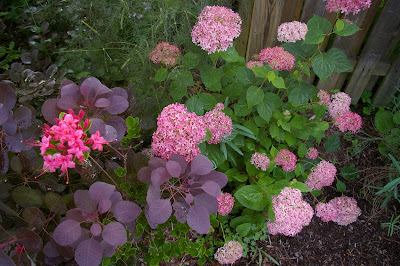 |
| My mom's favorite flower: gladiolus |
Day 36
The Daily DuBrule
I know a lot about a lot of plants. I am, in fact, a total plant geek. I swoon over unusual varieties. If I meet a plant I don't know, I immediately look it up and learn all about it. How ironic that my mother's favorite flower in the world was gladiolus, one of the most common flowers grown in gardens.
I never really liked gladiolus. I considered them them gawky. I never considered growing them in my own gardens. Every year on my parent's anniversary, I would buy them a large bouquet containing gladiolus and other flowers. As the years went by, I decided to buy them just gladiolus, the exact number that matched the years they were married. Eventually I had to buy a huge urn to hold bouquets of 35, 40, 45, 50, 55 stems. The ritual ended at year 56, when my mom finally passed away. Yes, her casket spray was a glorious mixture of gladiolus and other beautiful flowers. That is when I started planting them in my own gardens.
Now I think of them as one of the most beautiful flowers in the world. For sentimental reasons, I guess, but when you cut the flowers, one stem at a time, strip off the leaves and place that stem in a vase on your kitchen window sill, they are really gorgeous to study. They come in every color in the rainbow, streaked, bicolors, you name it. I still have an issue with how rigid and gawky they are in the garden. So now, I just weave them in amongst my perennials.
So many folks, when they are shopping in the garden center in the spring, just can't accept the idea of "tender bulbs". They say things like "if I have to dig them up and store them, forget it!". Glads are so totally simple to dig and store its ridiculous. I wait till the first frost. I loosen around them with my digging fork and pull them. I lay them on a flat lattice in my back garage for a week. Then I cut off the leaves and put them in a milk crate in my cellar for the winter. Period. Gladiolus are corms, very efficient storage organs. They keep really well. No fussing around. And, when you dig them, you find cormlets, baby corms that multiply your stock each year. I love saying the word cormlets.
 |
| Freshly dug gladiolus corms and cormlets |
I also grow Abyssinian gladiolus because they are graceful and fragrant. They are equally easy to raise, but because they smell so sweet, I locate them up close and personal, nearby the spots I tend to sit in the evening when I get home from work in late summer.
 |
Acidinanthera- Abyssinian gladiolus
|
Get with the program, fellow gardeners. Give tender bulbs a try. They will double the color in your garden and you will join the leagues of old fashioned gardeners everywhere who dig and store their tender bulbs in the fall. It is actually now a ritual I look forward to.

































